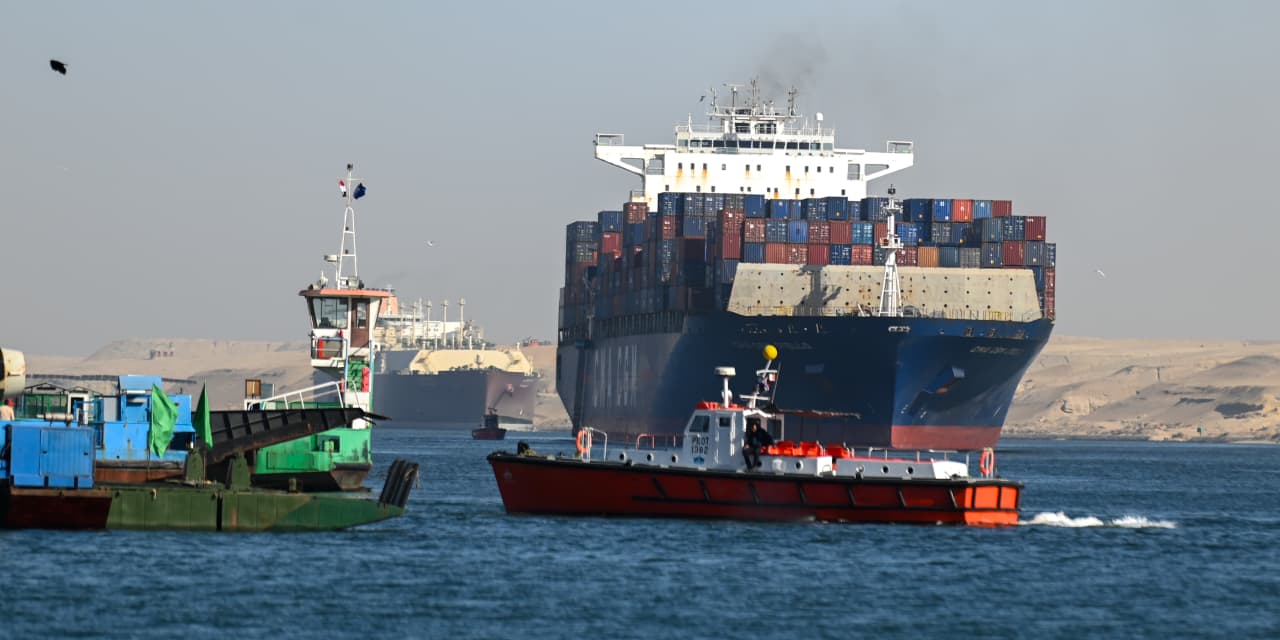A violent blockade of the Red Sea is starting to have wider economic implications that could show up in inflation and other economic data. It’s already impacting different parts of the global economy in varying ways—elevating returns for some companies, while depressing them for others. Oil and container shipping companies could see a boost, while some kinds of goods-makers that rely on imports and exports could be hurt.
Houthi militants in Yemen have been attacking merchant ships in the Red Sea since November in retaliation for Israel’s war in Gaza, and have not slowed the violence despite counterstrikes by American and British forces. Most container-ship traffic, including vessels controlled by giants like Maersk and Hapag-Lloyd has been avoiding the area, largely going around Africa’s Cape of Good Hope instead. Freight rates for ships going from Asia to Europe have tripled, while rates for ships going to the U.S. have doubled as total tanker availability has declined. A drought in the Panama Canal area has exacerbated the problem—because fewer ships can go through that shortcut, too.
Economists have generally been hesitant to put specific numbers on the impacts of the disruptions, though previous research by the International Monetary Fund found that when shipping costs double— as they have in the past month—it can cause global consumer prices to rise by 0.7 percentage points in the coming year. The size and timing of that effect, however, would depend on how long the blockade lasts.
Ben May, director of global macro research at Oxford Economics, wrote in a report earlier this month that the blockade would probably not result in a broader break from the wider trend of global disinflation. Central banks would still ease monetary policy, but it might not happen at the pace that markets currently expect.
“Based on the IMF’s estimates, were container transport costs across all routes to remain around their current levels – about 90% higher than a month ago – this might boost inflation by around 0.6 percentage points in a year’s time, with the effects gradually subsiding thereafter,” he wrote. “To put that in context, our current baseline forecast is for world [consumer price index] inflation to fall from 4.9% in first quarter 2024 to 3.4% in first quarter 2025, a little above the average of 2.9% in the five years prior to the pandemic.”
The business and investment impact varies by sector. Apparel and appliance-makers that ship products or buy foreign components, for instance, are likely to feel pressure because of rising freight rates. About 21% of global container ships travel through the Suez Canal, which links the Red Sea to the Mediterranean, according to Jefferies. Ikea and
Tesla
are among the companies that have been impacted by the disruptions.
Other American companies have started to talk about costs and delays, too.
Colgate-Palmolive
CFO Stanley Sutula said last week that the company is planning for “longer lead times” for products due to the Red Sea violence.
ResMed,
a San Diego company that makes items like medical sleep masks, said on an earnings call last week that it’s expecting freight costs to rise and impact results in an upcoming quarter.
While the disruption to the Red Sea has forced Maersk and competitors to reroute ships, the companies have benefited from the rise in freight rates. Its stock is up 32% since bottoming in November.
Hapag-Lloyd
stock is up 49% from its December low—and the company is now even offering land-based routes across Saudi Arabia from cities on the Persian Gulf to those on the Red Sea to handle the disruptions. “While this is not the optimal solution in terms of capacity, it will offer another option to the current transit times, especially where alternative routings become excessively long,” the company said.
Other kinds of companies are affected too, with the Wall Street Journal reporting on Thursday that mining giant BHP will divert shipments, potentially impacting materials used in industrial applications.
Oil and liquefied natural gas tankers are somewhat less affected than container ships, according to Jefferies. About 8% of crude tankers go through the Suez Canal, 12% of tankers carrying products like gasoline, and 11% of those carrying liquefied natural gas. Some oil tankers have continued to traverse the sea, including Saudi Arabian vessels, but not all of them. The shipping issues are one reason international oil prices rose 6% last week.
It’s also created some investment opportunities. In particular, oil product tankers classified as long range II, or LR2, have seen their rates jump to their highest levels in four years, according to Platts. In 2022 and 2023, rates averaged $40,000 a day. This past week, they crossed $100,000, according to Jefferies.
Scorpio Tankers
owns more of the tankers than any other company and should see significant gains as rates rise, according to Jefferies analyst Omar Nokta. He boosted his price target to $90 from $74 on Friday. That implies 26% upside for the stock, which closed on Friday at $71.65.
Write to Avi Salzman at [email protected]
Read the full article here




